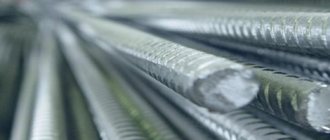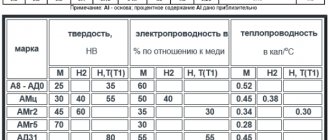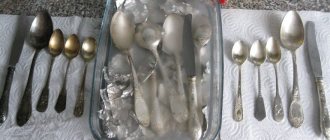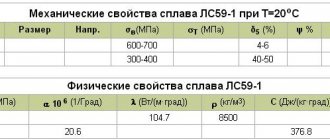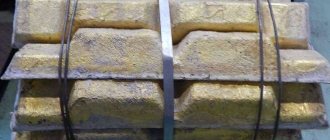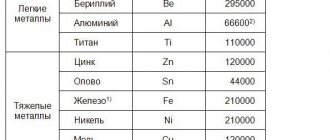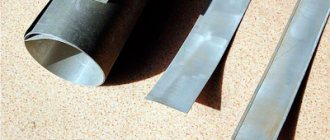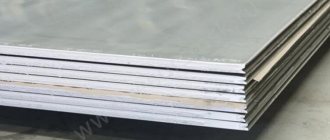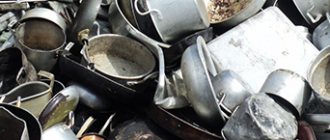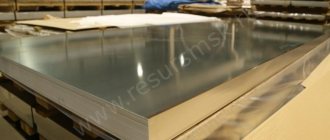The spread of modern technologies has led to the emergence of materials with exceptional performance properties. An example is duralumin, which is very common today. The characteristics of D16T allow the use of materials from this group in the manufacture of a wide variety of structures and mechanisms. Today, the alloy in question is used in the aviation and space industries, which can be associated with a combination of high strength and lightness.
Alloy D16T
Decoding of the D16T brand
Decoding the brand allows you to determine its main performance qualities and chemical composition. Brand D16T belongs to the class of duralumin, which is characterized by a high concentration of alloying elements.
Today, D16T is deciphered using GOST. Unlike other alloys, these alloys are marked according to their own system. Duralumin D16T is deciphered as follows:
- D – designation of materials of the duralumin group. It differs significantly from ordinary aluminum, which is due to the inclusion of various alloying elements in the composition. The concentration of other chemical elements allows you to change many performance qualities.
- 16 – alloy number. In essence, this figure does not indicate any qualities, but it is used to designate an alloy with certain qualities.
- T is a symbol that denotes hardening and natural aging. Heat treatment associated with hardening involves exposure to high temperatures, due to which the surface layer is reconstructed.
D16T aluminum is very common in areas where critical mechanisms and devices are produced that will be subject to serious environmental impact.
Download GOST 4784-97
Properties of material D16
D16 is a heat-strengthened deformable aluminum alloy, which has a chemical composition in accordance with GOST 4784-97.
Due to its low thermal and electrical conductivity, this material performs well at temperatures above 120 °C and up to 250 °C, but it is not allowed to be used even for a short time at temperatures above 500 °C. It is not prone to cracking, but when the temperature rises above 80 °C it is prone to the formation of intergranular corrosion, which imposes certain restrictions on its use. However, artificial aging allows you to avoid the formation of corrosion, with a simultaneous decrease in strength and ductility.
D16T has high hardness and strength, but is inferior in these parameters to workpieces made from VD95T1 alloy in a particularly hard state after artificial aging and hardening. But when the temperature rises above 120 °C, D16T exhibits better mechanical properties and has no equal up to 250 °C. In addition, it should be noted that VD95 is prone to stress corrosion, so it is not always possible to fully utilize the full potential of this material.
Most duralumin is prone to corrosion more than other aluminum alloys. For this reason, products made of duralumin are clad with a 2-4% layer of technical aluminum, or varnished. However, given the sometimes high temperature conditions of operation of parts made of duralumin, in most cases plating and anodizing are preferable, which affects the choice of sheet products produced under plating. In addition, D16T is difficult to weld and can only be welded by spot welding, therefore in most cases it is secured with rivets and other detachable and permanent connections.
Chemical composition
The chemical composition of each material has its own specific characteristics, which determine the physical and mechanical qualities.
The considered aluminum alloy D16T belongs to the Al-Cu-Mg group with manganese alloying. The chemical composition of the D16T alloy is characterized as follows:
- Most of the alloy is aluminum, the concentration of which reaches 94.7%.
- The rest of the mass comes from magnesium, copper and other various impurities.
- The inclusion of manganese in the composition significantly increases the corrosion resistance of the D16T alloy and increases some mechanical properties.
- The composition includes a small proportion of titanium and iron. The concentration of iron has a negative effect on the D16T alloy. This is due to the fact that such a chemical element does not dissolve in aluminum and creates inhomogeneous plates. The concentration of iron is maintained within strict limits, since a non-uniform structure can lead to serious problems.
Chemical composition of alloy D16T
Duralumin is produced with careful control of the concentration of all elements. An increase in the amount of iron in the composition leads to the fact that the metal becomes less homogeneous, due to which the quality decreases and other performance qualities deteriorate. Titanium and manganese must also be maintained within a certain concentration range, since too high and low levels can lead to changes in basic physical and mechanical properties.
Alloy d16t: brand decoding
Chemical composition of duralumin D16T
is strictly regulated
by GOST 4784-97 and is deciphered as follows:
- D – duralumin;
- 16 – alloy number in the series;
- T – hardened and naturally aged.
Duralumin D16T
refers to aluminum alloys of the Al-Cu-Mg system alloyed with manganese. Most of it is aluminum - up to 94.7%, the rest is copper, magnesium and other impurities. Manganese increases the corrosion resistance of the alloy and improves its mechanical properties, although it does not form common strengthening phases with aluminum, but only dispersed particles of the Al12Mn2Cu composition.
The characteristics of d16t are negatively affected by inclusions of iron, which does not dissolve in aluminum. Ferrum crystallizes in the duralumin alloy in the form of rough plates, significantly reducing its strength and ductility parameters. In addition, iron impurities bind copper, as a result of which the strength of the alloy decreases, reaching maximum values after natural aging. In this regard, its content in duralumin is very strictly limited by GOST and should not exceed a mass fraction of 0.5-0.7%.
In the West there is an analogue of the D16T
, the density of which is also 2.78 g/sq. see, but marked differently - 2024 t3511.
Material properties
Alloy D16T, the characteristics of which can be called very attractive, has a huge number of advantages in comparison with other alloys.
The features of duralumin determine that this alloy is in many ways superior to conventional aluminum and other materials. The physical and mechanical properties are as follows:
- High structural stability. Due to this, manufactured products can last a long time and withstand significant environmental impacts.
- The density of the material determines its low specific gravity, the level of which is 2800 kg/m3. Due to this, the resulting products become light. That is why D16T has become widespread in the aircraft industry and in the manufacture of elements that are used in the manufacture of equipment for the space industry. In order for the device to be able to overcome the earth's gravity with less energy consumption, the created structure must have low weight. Studies indicate that D16T is 3 times lighter than steel.
- Increased resistance to microscopic deformation during operation. This is due to the fact that the elastic modulus has a fairly high value.
- The high tensile strength of D16T is achieved due to the inclusion of a huge amount of alloying elements, for example, titanium. At the same time, the hardness of the D16T alloy is 42 MPa.
In addition, the melting point of D16T duralumin is quite high. Due to this, it is possible to use the alloy to create various devices that can be operated under high air resistance. Too high a resistance causes the metal to heat up and become softer and more ductile. The high melting point made it possible to use duralumin in the manufacture of aircraft, since ordinary aluminum heats up and becomes soft and less durable.
Characteristics and composition
The chemical composition of the D16T alloy is established by GOST 4784-97. It includes aluminum (up to 94.7%), copper (up to 4.9%), magnesium (up to 1.8%), manganese (up to 0.9%), silicon (up to 0.5%), iron ( up to 0.5%) and impurities of other metals (no more than 0.15%). The presence of these components increases the corrosion resistance and mechanical strength of the alloy. Silicon allows you to make a weld of higher quality, and the inclusion of nickel, for example, makes it possible to use the material at high temperatures.
Thanks to heat treatment, D16T duralumin becomes more durable and ductile. It is easy to cut, forge and stamp. Sheets, slabs, rods, pipes and angles are made from it. Products made of duralumin are 3 times lighter than their steel counterparts. Due to their high melting point, they can be used even under significant air resistance – for example, in the manufacture of aircraft.
Application area
The wide range of applications of D16T is associated with its basic performance qualities. It is worth considering that difficulties arising during the production process significantly increase the cost of this alloy. Despite the spread of aluminum, duralumin is used only when required. Alloy D16T is available in the following types:
- Sheets.
- Corners.
- Rods.
- Plates.
It is worth considering that the alloy is extremely rarely supplied to the production site in its pure form. To improve basic performance qualities, chemical-thermal treatment is often carried out. Blanks are used to produce the following products:
- Sheathing elements.
- Frames.
- Tractions.
- Spars.
Release form:
- In its purest form. As previously noted, blanks in this form are rare.
- In a hardened or naturally aged state.
- After artificial aging.
- Clad.
- Burnt out.
Rivets made from the material in question have become very widespread. This is due to the fact that rivets made of D16T are characterized by a high shear resistance.
Heat treatment can significantly increase basic performance qualities. According to established standards, this kind of improvement makes it possible to increase the resistance of the metal to high temperatures. For example, fasteners can withstand temperatures from 120 to 230 degrees Celsius. The alloy is also used in the mechanical engineering sector to create a body.
Release form
As mentioned earlier, D16 in its pure form, although used, is rarely used. And the low resistance to corrosion dictates the need for plating of rolled metal. Accordingly, the following types of semi-finished products from D16 are produced:
- In its purest form,
- T - hardened and naturally aged,
- T1 - artificially aged state.
- M - annealed,
- Clad (approx. D15TA)
From D16 they produce:
- Plates D16T,
- Sheets D16AT,
- Rods D16T,
- Corners D16,
- Sheet aluminum.
Rods with a diameter of up to 100 mm are produced in a naturally aged form in the T state, sometimes annealed - M, and sheets - clad in the M or T state, depending on the application.
Analogs D16T
There are quite a large number of foreign analogues on sale. Duralumin d16 is produced taking into account established standards and has the appropriate characteristics. D16T analogues are marked according to their own standards, for example, T3511.
When considering analogues, one should take into account the features of the heat treatment of D16ChT:
- First, temperature hardening is performed, for which the workpiece is heated to a temperature of 500 degrees Celsius. It is worth considering that too high a temperature leads to burning of aluminum and deterioration of its basic qualities. At the same time, changes occur abruptly. Therefore, you should pay a lot of attention to the temperature regime.
- The next step is cold water quenching. In this case, the temperature of the water is of great importance. The optimal value is considered to be the range from 250 to 350 degrees Celsius.
- Next, natural aging is carried out to improve the basic qualities. The process is quite simple: the surface is in contact with air, the temperature of which is similar to room temperature. The process lasts for 4-5 days.
As a result of the process, the surface acquires a hardness of about 125-130 HB. A similar indicator can be called the maximum value for the alloys of the group under consideration.
In conclusion, we note that the use of modern technologies makes it possible to maintain the concentration percentage of all elements strictly within the recommended range. Due to this, the quality of the alloy and its main characteristics are improved.
Heat treatment of alloy d16t
Duralumin D16T undergoes additional processing to improve its performance qualities:
- First of all, temperature hardening is carried out at 495-505 degrees. At higher temperatures, aluminum burns out, leading to a sharp decrease in the quality characteristics of the alloy.
- Secondly, duralumin is hardened in cold water, and the temperature of the cooling water has a great influence. The most optimal range in which the alloy achieves maximum resistance to intergranular corrosion and pitting is 250-350 degrees.
- And lastly, the D16T duralumin alloy undergoes natural aging, which is carried out at room temperature for 4-5 days.
As a result, after hardening and aging, the material acquires a hardness of 125-130 HB, which is the maximum among all known duralumins.
